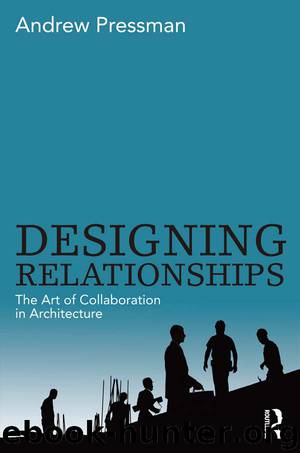Designing Relationships: The Art of Collaboration in Architecture by Andrew Pressman

Author:Andrew Pressman
Language: eng
Format: epub
ISBN: 9781315852355
Publisher: Routledge
CHARRETTES, WORKSHOPS, AND BRAINSTORMING SESSIONS
Charrettes, workshops, and brainstorming are among various terms used to describe a collaborative work session in which there is an uninterrupted, total immersion in design investigations in a compressed time frame dedicated to creating the building design—or alternatively the session is highly focused on some aspect of the design. The ideal times to conduct these sessions are at project inception, to jump-start design thinking, and at the various integration nodes (or those points of significant information exchange with consultants) during the course of the project. (See Chapter 4, for elaboration on this topic.) These sessions ensure the active participation of the key consultants and stakeholders, and, at the start, are a means to fully grasp all the programmatic, site, and budget factors; to develop more detailed questions; and to elicit critical feedback on preliminary ideas and the overarching vision for the project.
Brainstorming—the creative collaborative process used across many professions, industries, and businesses—has been successfully deployed in some form for many years. First described by Alex Osborn21 in 1939, many of the principles outlined below are still valid today and are amenable to collaboration in architectural design. They are worth repeating and underscoring.
■
Do not criticize or judge ideas. Evaluation should occur after the collaborative session—not while brainstorming is in process, otherwise (1) team members will be reticent about speaking up and (2) kernels of potentially novel ideas will not have a chance for discussion and development. Work hard to mitigate the natural tendency that we all have to constantly evaluate.
■
Generate unfettered, wild, and crazy ideas. In addition to generating the usual array of standard or expected solutions, this strategy has a greater probability of leading to a solution that is innovative and creative.
■
Try to develop as many ideas as possible. The more ideas that are on the table—flawed or not—the better chance to trigger something special and excellent. Perfection is not the goal; sheer quantity is.
■
Combine and build upon ideas. Synthesizing or improving upon ideas that have been proposed should be part of the natural progression of a brainstorming session. This is one of the unique and wonderful outcomes of collaborative work.
Several additional salient observations with regard to leading brainstorming sessions include the following. It almost goes without saying that the leader should not be condescending, arrogant, or egotistical because the quieter members will be even more reluctant to participate. At regular intervals, or after the session, take stock and summarize important points, design ideas, features, etc. and compare those to the overarching objectives for the project. The leader can be the facilitator for the session but also the designer of it, ensuring appropriate engagement and accomplishment in accordance with the distinctive role of each collaborator and, of course, the agenda.
Keep the brainstorming team as small as possible; as a general rule, less than ten is best although sessions can work with many more participants. And, notwithstanding the inherent excitement of such a session in kicking off a project, one secondary benefit is the camaraderie among collaborators in creating something special together.
Download
This site does not store any files on its server. We only index and link to content provided by other sites. Please contact the content providers to delete copyright contents if any and email us, we'll remove relevant links or contents immediately.
Kathy Andrews Collection by Kathy Andrews(10506)
The remains of the day by Kazuo Ishiguro(7542)
Spare by Prince Harry The Duke of Sussex(4188)
Paper Towns by Green John(4163)
The Body: A Guide for Occupants by Bill Bryson(3789)
Be in a Treehouse by Pete Nelson(3206)
Harry Potter and the Goblet Of Fire by J.K. Rowling(3025)
Goodbye Paradise(2949)
Never by Ken Follett(2872)
Into Thin Air by Jon Krakauer(2695)
The Remains of the Day by Kazuo Ishiguro(2614)
The Genius of Japanese Carpentry by Azby Brown(2602)
The Cellar by Natasha Preston(2592)
Drawing Shortcuts: Developing Quick Drawing Skills Using Today's Technology by Leggitt Jim(2528)
120 Days of Sodom by Marquis de Sade(2428)
Architecture 101 by Nicole Bridge(2348)
The Man Who Died Twice by Richard Osman(2289)
Machine Learning at Scale with H2O by Gregory Keys | David Whiting(2264)
Fairy Tale by Stephen King(2058)
